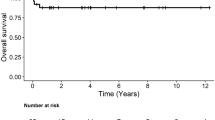Abstract
Based on outcome data, surgery is recommended for asymptomatic adults with chronic mitral regurgitation (MR) and systolic dysfunction, marked left ventricular (LV) dilation, pulmonary hypertension, atrial fibrillation, or high likelihood of successful repair; but indications for children are poorly defined. We sought to determine predictors of postoperative LV dysfunction in asymptomatic children with chronic MR. The surgical database was searched for all children who underwent mitral valve surgery for chronic MR (2000–2012). Exclusion criteria were preoperative symptoms, acute MR, cardiomyopathy, or other defects affecting LV size. Preoperative and latest follow-up clinical and echocardiographic data were obtained. LV dysfunction was defined as ejection fraction (EF) ≤55 % or shortening fraction (SF) ≤28 %. Associations between preoperative factors and late LV dysfunction were determined using univariate Poisson regression. For the 25 children who met criteria, preoperative median LV end systolic Z score (LVESZ) was 5.3, EF was 65 %, and SF was 34 %. At follow-up (median 3.9 years), nine patients (36 %) had LV dysfunction. Lower preoperative SF (OR 0.6, p < 0.001) and higher LVESZ (OR 1.7, p < 0.01) were associated with late LV dysfunction. LVESZ ≥ 5 combined with SF ≤ 33 % had a sensitivity of 89 %, specificity of 88 %, and negative predictive value of 93 % for late LV dysfunction. Only 1/14 patients with preoperative SF > 33 % had late LV dysfunction. For asymptomatic children with chronic MR, surgery should be considered before LVESZ exceeds five and SF falls below 33 %. Patients with SF > 33 % may be followed with serial echocardiographic measurements.

Similar content being viewed by others
References
Bonow RO, Carabello BA, Chatterjee K, de Leon AC Jr, Faxon DP, Freed MD, Gaasch WH, Lytle BW, Nishimura RA, O’Gara PT, O’Rourke RA, Otto CM, Shah PM, Shanewise JS (2008) 2008 focused update incorporated into the ACC/AHA 2006 guidelines for the management of patients with valvular heart disease: a report of the American College of Cardiology/American Heart Association Task Force on Practice Guidelines (Writing Committee to revise the 1998 guidelines for the management of patients with valvular heart disease). Endorsed by the Society of Cardiovascular Anesthesiologists, Society for Cardiovascular Angiography and Interventions, and Society of Thoracic Surgeons. J Am Coll Cardiol 52:e1–e142
Buddhe S, Du W, Walters HLI, Delius R, Pettersen MD (2013) Predictors of left ventricular remodeling after aortic valve replacement in pediatric patients with isolated aortic regurgitation. Congenit Heart Dis 8:167–173
Chenot F, Montant P, Vancraeynest D, Pasquet A, Gerber B, Noirhomme PH, El Khoury G, Vanoverschelde J-L (2009) Long-term clinical outcome of mitral valve repair in asymptomatic severe mitral regurgitation. Eur J Cardiothorac Surg 36:539–545
Enriquez-Sarano M, Tajik AJ, Schaff HV, Orszulak TA, Bailey KR, Frye RL (1994) Echocardiographic prediction of survival after surgical correction of organic mitral regurgitation. Circulation 90:830–837
Kang DH, Kim JH, Rim JH, Kim MJ, Yun SC, Song JM, Song H, Choi KJ, Song JK, Lee JW (2009) Comparison of early surgery versus conventional treatment in asymptomatic severe mitral regurgitation. Circulation 119:797–804
Krishnan US, Gersony WM, Berman-Rosenzweig E, Apfel HD (1997) Late left ventricular function after surgery for children with chronic symptomatic mitral regurgitation. Circulation 96:4280–4285
Lee JY, Noh CI, Bae EJ, Yun YS, Lee JR, Kim YJ (2003) Preoperative left ventricular end systolic dimension as a predictor of postoperative ventricular dysfunction in children with mitral regurgitation. Heart 89:1243–1244
Lopez L, Colan SD, Frommelt PC, Ensing GJ, Kendall K, Younoszai AK, Lai WW, Geva T (2010) Recommendations for quantification methods during the performance of a pediatric echocardiogram: a report from the Pediatric Measurements Writing Group of the American Society of Echocardiography Pediatric and Congenital Heart Disease Council. J Am Soc Echocardiogr 23:465–495
Maffessanti F, Caiani EG, Tamborini G, Muratori M, Sugeng L, Weinert L, Alamanni F, Zanobini M, Mor-Avi V, Lang RM, Pepi M (2010) Serial changes in left ventricular shape following early mitral valve repair. Am J Cardiol 106:836–842
Rosenhek R, Rader F, Klaar U, Gabriel H, Krejc M, Kalbeck D, Schemper M, Maurer G, Baumgartner H (2006) Outcome of watchful waiting in asymptomatic severe mitral regurgitation. Circulation 113:2238–2244
Ross RD, Bollinger RO, Pinsky WW (1992) Grading the severity of congestive heart failure in infants. Pediatr Cardiol 13:72–75
Selamet Tierney ES, Gal D, Gauvreau K, Zhou J, Soluk Y, McElhinney DB, Colan SD, Geva T (2013) Echocardiographic predictors of left ventricular dysfunction after aortic valve surgery in children with chronic aortic regurgitation. Congenit Heart Dis 8:308–315
Senechal M, MacHaalany J, Bertrand OF, O’Connor K, Parenteau J, Dubois-Senechal IN, Costerousse O, Dubois M, Voisine P (2013) Predictors of left ventricular remodeling after surgical repair or replacement for pure severe mitral regurgitation caused by leaflet prolapse. Am J Cardiol 112:567–573
Acknowledgments
This investigation was supported by the University of Utah Study Design and Biostatistics Center, with funding in part from the National Center for Research Resources and the National Center for Advancing Translational Sciences, National Institutes of Health, through Grant 8UL1TR000105 (formerly UL1RR025764).
Author information
Authors and Affiliations
Corresponding author
Rights and permissions
About this article
Cite this article
Johnson, J.T., Eckhauser, A.W., Pinto, N.M. et al. Indications for Intervention in Asymptomatic Children with Chronic Mitral Regurgitation. Pediatr Cardiol 36, 417–422 (2015). https://doi.org/10.1007/s00246-014-1026-z
Received:
Accepted:
Published:
Issue Date:
DOI: https://doi.org/10.1007/s00246-014-1026-z




